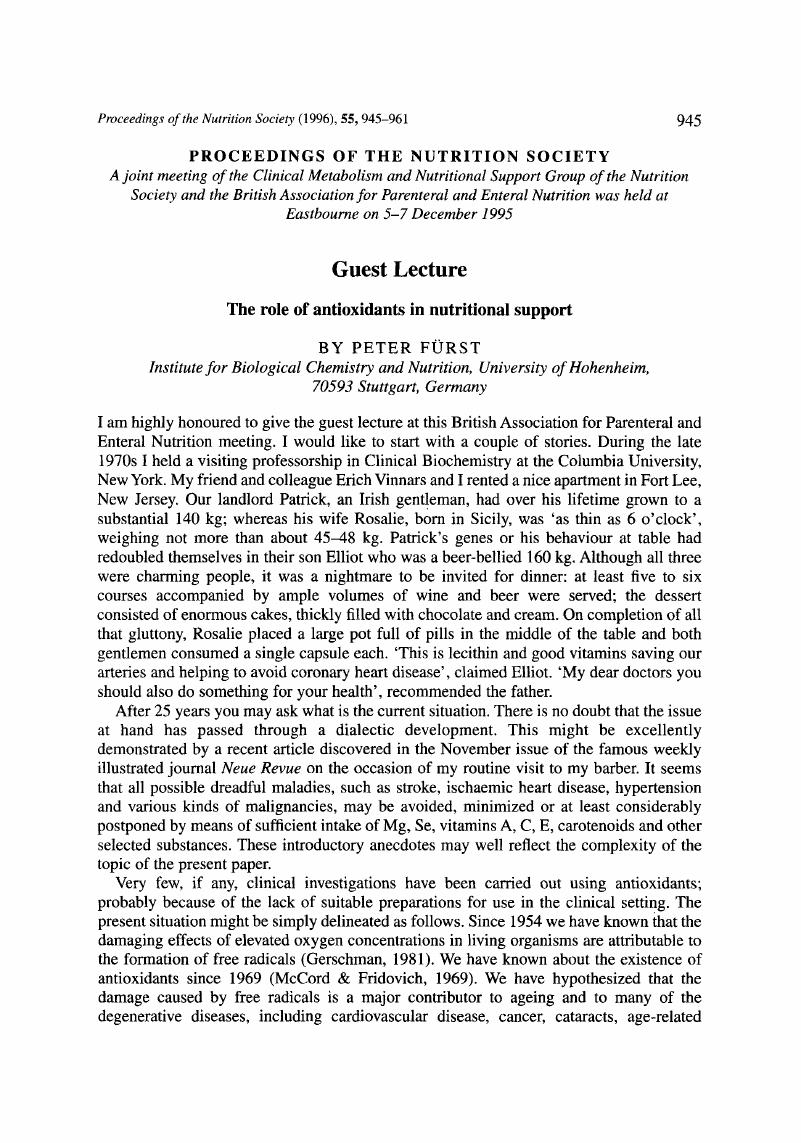Crossref Citations
This article has been cited by the following publications. This list is generated based on data provided by Crossref.
Morlion, Bart J.
Stehle, Peter
Wachtler, Paul
Siedhoff, Hans-P.
Köller, Manfred
König, Wolfgang
Fürst, Peter
and
Puchstein, Christoph
1998.
Total Parenteral Nutrition With Glutamine Dipeptide After Major Abdominal Surgery.
Annals of Surgery,
Vol. 227,
Issue. 2,
p.
302.
Bałasińska, Bożena
1998.
Hypocholesterolemic effect of dietary evening primrose (Oenothera paradoxa) cake extract in rats.
Food Chemistry,
Vol. 63,
Issue. 4,
p.
453.
Fürst, Peter
and
Ziegler, Thomas R.
1998.
Protein and amino acid metabolism and therapy: what is new and what has been left aside.
Current Opinion in Clinical Nutrition and Metabolic Care,
Vol. 1,
Issue. 1,
p.
59.
De-Souza, Daurea Abadia
and
Greene, Lewis Joel
1998.
Pharmacological Nutrition After Burn Injury.
The Journal of Nutrition,
Vol. 128,
Issue. 5,
p.
797.
Fürst, Peter
Kuhn, Katharina S.
and
Ziegler, Thomas R.
1999.
Amino acids and proteins - new definitions and requirements, hormonal interactions, methodological advances and pitfalls.
Current Opinion in Clinical Nutrition and Metabolic Care,
Vol. 2,
Issue. 1,
p.
5.
Shenkin, Alan
2000.
Part 2 Micronutrients in the severely-injured patient.
Proceedings of the Nutrition Society,
Vol. 59,
Issue. 3,
p.
451.
Fürst, Peter
2000.
A Thirty‐Year Odyssey in Nitrogen Metabolism: From Ammonium to Dipeptides.
Journal of Parenteral and Enteral Nutrition,
Vol. 24,
Issue. 4,
p.
197.
Scherbaum, Veronika
and
Fürst, Peter
2000.
New concepts on nutritional management of severe malnutrition: the role of protein.
Current Opinion in Clinical Nutrition and Metabolic Care,
Vol. 3,
Issue. 1,
p.
31.
Schweigert, Florian J.
2001.
Inflammation-induced changes in the nutritional biomarkers serum retinol and carotenoids.
Current Opinion in Clinical Nutrition and Metabolic Care,
Vol. 4,
Issue. 6,
p.
477.
Domı́nguez, C.
Guillén, D.A.
and
Barroso, C.G.
2001.
Automated solid-phase extraction for sample preparation followed by high-performance liquid chromatography with diode array and mass spectrometric detection for the analysis of resveratrol derivatives in wine.
Journal of Chromatography A,
Vol. 918,
Issue. 2,
p.
303.
Cresci, Gail
and
Martindale, Robert
2001.
Handbook of Nutrition and Food.
Fürst, P.
Kuhn, K. S.
and
Stehle, P.
2002.
From Nutrition Support to Pharmacologic Nutrition in the ICU.
p.
441.
Stratton, Rebecca J.
and
Smith, Trevor R.
2006.
Role of enteral and parenteral nutrition in the patient with gastrointestinal and liver disease.
Best Practice & Research Clinical Gastroenterology,
Vol. 20,
Issue. 3,
p.
441.
Petit, A.
and
Déchelotte, P.
2007.
Traité de nutrition artificielle de l’adulte.
p.
681.
Martindale, Robert
and
Cresci, Gail
2007.
Handbook of Nutrition and Food, Second Edition.
p.
1159.
Fürst, Peter
2009.
Basics in clinical nutrition: Role of antioxidants in nutritional support.
e-SPEN, the European e-Journal of Clinical Nutrition and Metabolism,
Vol. 4,
Issue. 3,
p.
e105.
Durzan, Don J
2009.
Arginine, scurvy and Cartier's "tree of life".
Journal of Ethnobiology and Ethnomedicine,
Vol. 5,
Issue. 1,
Preiser, Jean‐Charles
2012.
Oxidative Stress.
Journal of Parenteral and Enteral Nutrition,
Vol. 36,
Issue. 2,
p.
147.
Gallinat, Anja
Lüer, Bastian
Swoboda, Sandra
Rauen, Ursula
Paul, Andreas
and
Minor, Thomas
2013.
Use of the new preservation solution Custodiol-N supplemented with dextran for hypothermic machine perfusion of the kidney.
Cryobiology,
Vol. 66,
Issue. 2,
p.
131.



